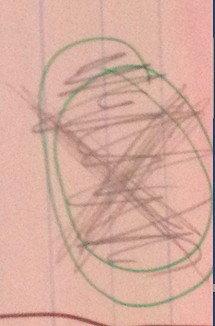In my last post, I described three boys attempting to model a problem about servings of chicken and potatoes. My colleague and I were watching the boys wrestle with how to represent the potato servings with fraction circles. At the end of the post, I “saved” the boys from crossing out their representation and starting all over.
I tend to consider myself a pretty decent math teacher. I try not to say anything that a kid can say. I ask a lot of questions. I use rich tasks that promote deep thinking. I encourage my students to persevere and engage in productive struggle. And, yet, here I was rescuing these boys from their learning. What, exactly, was I saving them from? Maybe I thought I was saving them from starting over.
A mathy friend read my last post and she asked me, “why didn’t you let them cross it out?”
“because I….. Well, I thought I…..hmmmm. Oh, man. Why DIDN’T I let them cross it out?” I sighed as I realized that I may have hijaked their learning. I saw those boys on the edge and I yanked them right back away from it. Why did I do that? Maybe I felt rushed. I was super excited to watch them in the thick of making some really cool connections. Maybe old habits are hard to break. Did I ruin their learning? Of course not. Would it have been interesting to see what the boys would have done if I hadn’t said, “wait!”? I think so.
It is really challenging to maintain the balance of providing and removing scaffolding for students. How do we keep the struggle productive? What makes a struggle productive? I have been thinking about this for awhile now. Here is what I came up with:
A struggle is productive when learning is happening, connections are being made, questions are being asked, and doubt and uncertainty are being examined.
My colleague and I were on a learning round. We were “looking for” evidence of students checking to see if an answer makes sense within the context of a situation and changing a model when necessary. In my last post, I commented that I thought the boys were abandoning their model if they crossed it out, but I have changed my thinking. I don’t think they were abandoning their model. I think they wanted to change their model so it more accurately reflected the context of the situation. They were sense making. They were struggling productively.
I love looking at student work. It is amazing. I often walk away with more questions than answers, but that is okay. I also walk away with a deeper appreciation for how my students are making sense of math. Below is the poster that the boys shared with their teacher and their classmates after they had finished solving the problem. The top portion is their work on the potatoes part of the problem. The bottom portion is their work on the chicken part of the problem. They completed the bottom part after I left. I have been looking at their work for awhile. I think it is beautiful.

My favorite parts are the “cross outs”.






 (replication of student work)
(replication of student work)
